This article was co-authored by Mayami Oyanagi. Mayami Oyanagi is a Physical Therapist and the owner of PT STOP Physical Therapy & Wellness, an individualized physical therapy practice in Los Angeles, California. With over 14 years of experience, Mayami specializes in orthopedic injuries, manual therapy, and sports medicine. She holds an MS in Physical Therapy from the University of Hartford. Mayami is also a board certified Orthopedic Clinical Specialist. She treats the root cause of her client’s problems by utilizing biomechanical assessments.
There are 11 references cited in this article, which can be found at the bottom of the page.
wikiHow marks an article as reader-approved once it receives enough positive feedback. This article received 11 testimonials and 84% of readers who voted found it helpful, earning it our reader-approved status.
This article has been viewed 356,745 times.
If you have hurt yourself or you had to undergo surgery and cannot bear weight on a leg, your doctor may recommend crutches for you. Crutches are medical devices that allow you to continue being mobile while your injured leg heals. Using crutches can be a challenge. See if a family member can help you when you are first getting started with them. Be sure your crutches are adjusted to the proper height before using them.
Steps
Positioning the Crutches
-
1Wear the shoes that you will normally wear. Before you position the crutches, make sure you're wearing the shoes that you'll wear for normal, everyday activity. This will make sure that you're at the right height when you adjust your crutches.[1]
-
2Position crutches correctly for your height. Using crutches at the incorrect height can lead to nerve damage in the armpit area.[2] You should have about 1 ½ inches between your armpit and the top of the crutch when the crutches are in a normal position. In other words, the pads on the crutches should not be squeezed to your sides or an unnecessary distance from your body.[3]
- When you use the crutches, you will place the arm pads under your armpits, not right inside them.
Advertisement -
3Adjust the crutches. Adjust your crutches so that when you are standing upright with your hands at your sides, the handles sit just under your palms. The arm guards should be about 1 inch or 3 centimeters above your elbow.
- When you first get crutches, your doctor or a nurse may help you adjust them for the first time.
-
4Align the handpiece with your hip. You can reposition this piece by removing the wing nut and sliding the bolt out of the hole. Slide the hand bar to the appropriate location, insert the bolt, and fasten the nut.[4]
-
5Call your doctor if you do not feel safe on crutches. There may options for devices other than crutches, depending on the type of injury.
-
6See a physical therapist. You can ask your doctor about physical therapy, which is a commonly recommended option when you need to use crutches. A physical therapist will help you learn how to use crutches properly and can monitor your progress. Because crutches are often prescribed after an injury or surgery, you may need rehabilitation as well.
- Your doctor may recommend at least a few sessions with a physical therapist to help you get the hang of crutches. If you cannot put any weight on your leg, your doctor will likely send you to the physical therapist before you leave the hospital so that you can learn how to move around properly.[7]
- If you have had surgery on your leg or knee, you will likely need to see a physical therapist for rehabilitation. Your PT will make sure that you are stable and able to walk safely using your crutches. The PT will also work with you to develop your strength and mobility.
Walking with Crutches
-
1Put your crutches in place. The crutches should be positioned straight up-and-down to begin. Position the shoulder pads slightly wider than your shoulders so that you can fit between the crutches when you stand up. The feet of the crutches should be next to your feet, and the pads should be underneath your arms. Place your hands on the hand pieces.[8]
-
2Put your weight on the good (uninjured) leg. Push down on the hand pieces of the crutches as you stand up, keeping your injured leg or foot off of the floor. All of your weight should be on your good leg. You may want to ask for help from a friend or family member.[9]
- If you need to, hold on to something stable like a piece of heavy furniture or a railing while you are adjusting to moving around independently.
-
3Take a step. To take a step, start by placing the foot pads of the crutches a short distance in front of you, ensuring that they are slightly wider than shoulder width apart. The distance should be short enough that you feel stable, about 12 inches. When stable and ready, lean on the crutches by loosely gripping and then pushing against the handles and straightening your arms, transferring your weight onto your arms. Swing your body slowly through the gap between the crutches, lifting your good leg and moving it forward. Place the foot of the good leg flat on the ground, keeping the other leg next to the good leg. Repeat the process until you get to your destination.
- When pivoting, pivot with the strong leg, not the weak leg.[10]
- As your injury begins to heal you will feel more comfortable taking larger steps but the crutches should never be much farther forward than your bad foot's toes; otherwise, you'll most likely be caught off balance and increase the possibility of falling. Be careful especially the first few days on the crutches. They can be a challenge to many people.
-
4Distribute your weight correctly as you walk. Lean on the crutches and swing forward, slowly shifting your weight forward using your forearms, not your elbows. Be sure to have a slight bend to the elbow, and use your arm muscles; do not lean on your armpits.
- When leaning, don't lean on your armpits; it will hurt and may cause you to develop a painful rash. Instead, lean on your hands using your arm muscles.
- You can put socks or a rolled up towel on the armpit pad to help prevent a rash.[11]
- Leaning on the armpit can lead to a condition called radial nerve palsy. If this happens, the wrist and hand can become weak, and occasional the back of the hand can lose feeling [12] The good news, is if the pressure is relieved, the injury usually heals itself.
- Leaning on the armpit could also cause brachial plexus injury, or "crutch palsy," or rotator cuff tendonitis, which causes inflammation and pain in the shoulder and outer arm.[13]
-
5Avoid gripping the handles too tightly. Doing so may cause a cramp in your fingers and increase numbness in your hands. Try to relax your hands as much as possible. To avoid cramps, try to keep your fingers cupped so the crutches 'drop' into your fingers when leaving the ground. This will relieve pressure on your palms and let you walk farther with much less discomfort.
-
6Use a backpack to carry things. Using a messenger bag or a handbag on one side could interfere with your crutches. It may also throw you off balance. Use a backpack to carry things around when you're using crutches.[14]
Sitting and Using Stairs with Crutches
-
1Back up to a chair to sit. Balance on your good leg and put both crutches under the arm on the same side as your weak leg. Use your other hand to feel behind you for the chair. Slowly lower yourself into the chair, lifting your weak leg as you sit.[15] When you are seated, lean your crutches upside-down in a nearby spot so they don’t fall over out of reach.
-
2Take any stairs carefully. Stand facing the stairs, and whichever side the banister/railing is on, put that crutch under your arm on the opposite side. You should now have one hand free to hold the railing and one hand with a crutch to take weight, with the second crutch resting under your arm.
- If possible, have someone carry the unused crutch for you.
- Whenever possible, take the elevator instead of the stairs while you are on crutches.[16]
-
3Place the crutch on the ground first. The crutch should be next to you, on the outside of your good leg. You should hold the banister or handrail with the hand that is on the same side as your bad leg. Leave the crutch in place until you have stepped up, then move the crutch up to meet you on your current step. Do not lead with the crutch.
-
4Lift your good leg up to the first step. Use that leg to move the rest of your body weight up. Then follow with the crutch, so that the crutch is on your current step with you. Now repeat that until you get to the top of the stairs. Your good leg should do the majority of the lifting, and your arms should be used just for support and balance. Coming down stairs, you should put your bad leg and crutch on the step down, then use your good leg to move your body weight down. [17]
- If you get confused about which way it goes, the good leg is always the highest on the stairs, as it always takes the strain of moving your body's weight. Try to remember the saying, “Good leg up, bad leg down” Good leg goes first when you go up the steps, the bad (injured) leg is first when going down the steps.
- With practice you can also use both crutches to take the stairs, but you need to be very careful on steps. The same concept is done, “down with the bad leg.”[18]
-
5Try scooting. If you feel too unsteady on the stairs, you can sit on each step and scoot your bottom up and down. Start with sitting on the bottom step with the injured leg in front of you. Scoot your body up and sit on the next step, hold both crutches with you in the opposite hand and moving up the steps with them. When going down, do the same. Take your crutches in the free hand and use your other hand and good leg to support yourself while going down.[19]
Expert Q&A
Did you know you can get expert answers for this article?
Unlock expert answers by supporting wikiHow
-
QuestionHow can I make sure my crutches fit properly?
 Mayami OyanagiMayami Oyanagi is a Physical Therapist and the owner of PT STOP Physical Therapy & Wellness, an individualized physical therapy practice in Los Angeles, California. With over 14 years of experience, Mayami specializes in orthopedic injuries, manual therapy, and sports medicine. She holds an MS in Physical Therapy from the University of Hartford. Mayami is also a board certified Orthopedic Clinical Specialist. She treats the root cause of her client’s problems by utilizing biomechanical assessments.
Mayami OyanagiMayami Oyanagi is a Physical Therapist and the owner of PT STOP Physical Therapy & Wellness, an individualized physical therapy practice in Los Angeles, California. With over 14 years of experience, Mayami specializes in orthopedic injuries, manual therapy, and sports medicine. She holds an MS in Physical Therapy from the University of Hartford. Mayami is also a board certified Orthopedic Clinical Specialist. She treats the root cause of her client’s problems by utilizing biomechanical assessments.
Physical Therapist You want to make sure a medical provider is fitting for you. Usually, you put two or three fingers under your armpit. That should be the distance between the top of the crutches and your armpit. Then the hand support should be at the height of the wrist. The crutches should go under the armpit first, and then you check the arm length in relation to the crutch length. The wrist height should be where the holder for the arm in the crutches is.
You want to make sure a medical provider is fitting for you. Usually, you put two or three fingers under your armpit. That should be the distance between the top of the crutches and your armpit. Then the hand support should be at the height of the wrist. The crutches should go under the armpit first, and then you check the arm length in relation to the crutch length. The wrist height should be where the holder for the arm in the crutches is. -
QuestionHow do I keep from falling when I lean backwards, since I can't bend my knee?
 Chris M. Matsko, MDDr. Chris M. Matsko is a retired physician based in Pittsburgh, Pennsylvania. With over 25 years of medical research experience, Dr. Matsko was awarded the Pittsburgh Cornell University Leadership Award for Excellence. He holds a BS in Nutritional Science from Cornell University and an MD from the Temple University School of Medicine in 2007. Dr. Matsko earned a Research Writing Certification from the American Medical Writers Association (AMWA) in 2016 and a Medical Writing & Editing Certification from the University of Chicago in 2017.
Chris M. Matsko, MDDr. Chris M. Matsko is a retired physician based in Pittsburgh, Pennsylvania. With over 25 years of medical research experience, Dr. Matsko was awarded the Pittsburgh Cornell University Leadership Award for Excellence. He holds a BS in Nutritional Science from Cornell University and an MD from the Temple University School of Medicine in 2007. Dr. Matsko earned a Research Writing Certification from the American Medical Writers Association (AMWA) in 2016 and a Medical Writing & Editing Certification from the University of Chicago in 2017.
Family Medicine Physician
-
QuestionCan crutches help if both legs are compromised?
 Chris M. Matsko, MDDr. Chris M. Matsko is a retired physician based in Pittsburgh, Pennsylvania. With over 25 years of medical research experience, Dr. Matsko was awarded the Pittsburgh Cornell University Leadership Award for Excellence. He holds a BS in Nutritional Science from Cornell University and an MD from the Temple University School of Medicine in 2007. Dr. Matsko earned a Research Writing Certification from the American Medical Writers Association (AMWA) in 2016 and a Medical Writing & Editing Certification from the University of Chicago in 2017.
Chris M. Matsko, MDDr. Chris M. Matsko is a retired physician based in Pittsburgh, Pennsylvania. With over 25 years of medical research experience, Dr. Matsko was awarded the Pittsburgh Cornell University Leadership Award for Excellence. He holds a BS in Nutritional Science from Cornell University and an MD from the Temple University School of Medicine in 2007. Dr. Matsko earned a Research Writing Certification from the American Medical Writers Association (AMWA) in 2016 and a Medical Writing & Editing Certification from the University of Chicago in 2017.
Family Medicine Physician
References
- ↑ http://www.merckmanuals.com/professional/special-subjects/rehabilitation/therapeutic-and-assistive-devices
- ↑ http://www.merckmanuals.com/home/brain_spinal_cord_and_nerve_disorders/peripheral_nerve_disorders/mononeuropathy.html
- ↑ http://www.nlm.nih.gov/medlineplus/ency/patientinstructions/000344.htm
- ↑ http://orthoinfo.aaos.org/topic.cfm?topic=a00181
- ↑ http://www.nlm.nih.gov/medlineplus/ency/patientinstructions/000640.htm
- ↑ http://orthoinfo.aaos.org/topic.cfm?topic=a00181
- ↑ http://kidshealth.org/kid/ill_injure/aches/physical_therapy.html
- ↑ http://www.upmc.com/patients-visitors/education/rehab/Pages/walking-with-crutches-3-point-sequence.aspx
- ↑ http://www.upmc.com/patients-visitors/education/rehab/Pages/walking-with-crutches-3-point-sequence.aspx
- ↑ https://orthospecialtyclinic.com/wp-content/uploads/2013/04/OSC-Gait-Instructions.pdf
- ↑ https://iwalk-free.com/blog/how-to-stop-crutches-from-hurting-your-armpits/
- ↑ http://www.merckmanuals.com/home/brain_spinal_cord_and_nerve_disorders/peripheral_nerve_disorders/mononeuropathy.html
- ↑ https://my.clevelandclinic.org/services/orthopaedics-rheumatology/diseases-conditions/rotator-cuff-tendonitis
- ↑ http://www.upmc.com/patients-visitors/education/rehab/Pages/walking-with-crutches-3-point-sequence.aspx
- ↑ https://myhealth.ucsd.edu/RelatedItems/3,86011
- ↑ http://www.upmc.com/patients-visitors/education/rehab/Pages/walking-with-crutches-3-point-sequence.aspx
- ↑ http://www.nlm.nih.gov/medlineplus/ency/patientinstructions/000344.htm
- ↑ http://www.nlm.nih.gov/medlineplus/ency/patientinstructions/000344.htm
- ↑ http://orthoinfo.aaos.org/topic.cfm?topic=a00181
About This Article
To walk on crutches, start by positioning the pads of the crutches underneath your arms. Then, put all your weight on your good leg. Next, move the crutches, putting the foot pads in front of you and slightly wider than shoulder-width apart. Once you've moved the crutches forward, transfer your weight to your arms and swing your body through the crutches, lifting your good leg and moving it forward. Be sure to use your arm muscles to carry your weight rather than leaning your armpits on the crutches, which can injure your arm or shoulder. For tips from our Medical reviewer on how to sit, stand, or go up and down the stairs with crutches, read on!
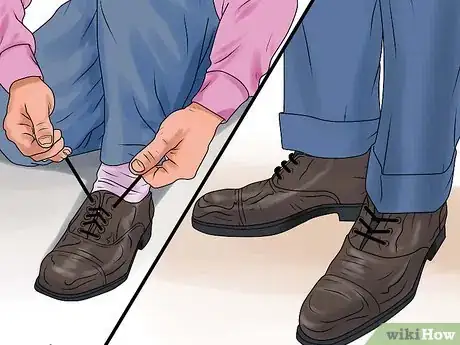

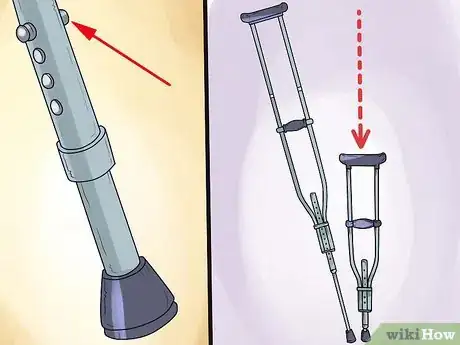
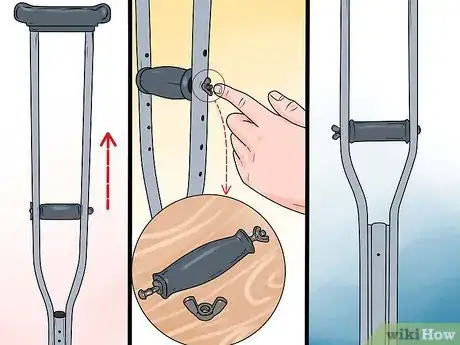

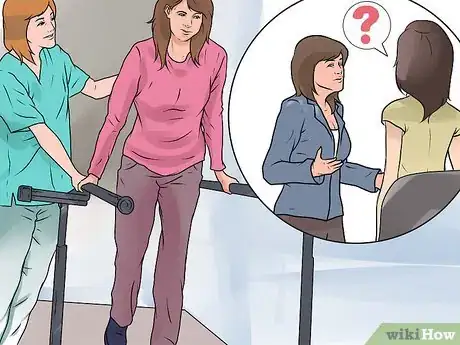

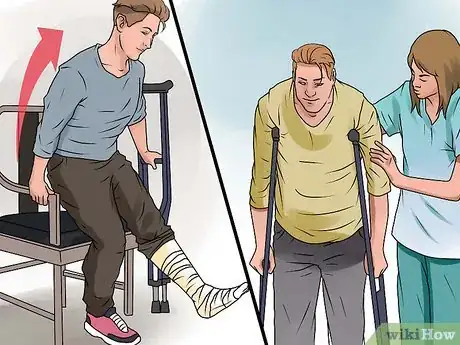

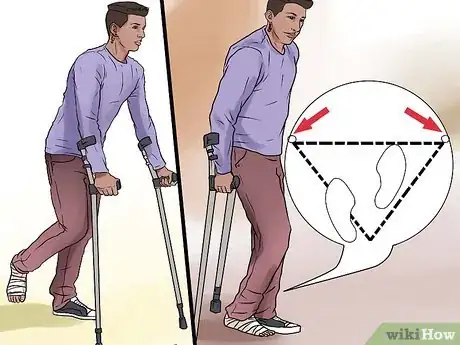
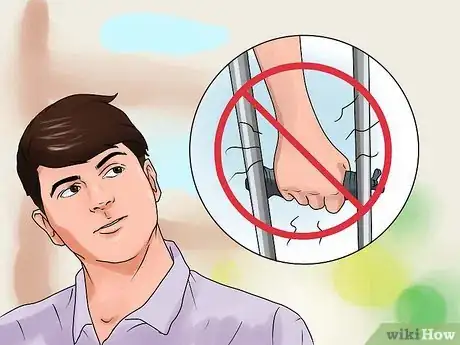

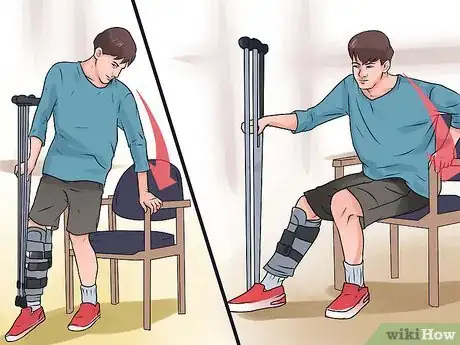

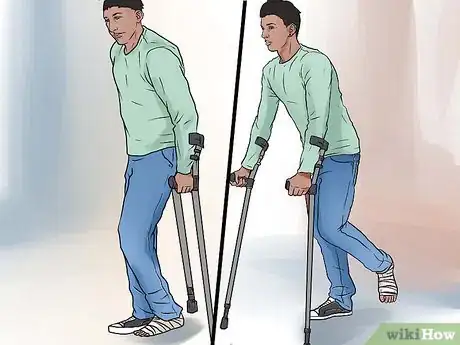
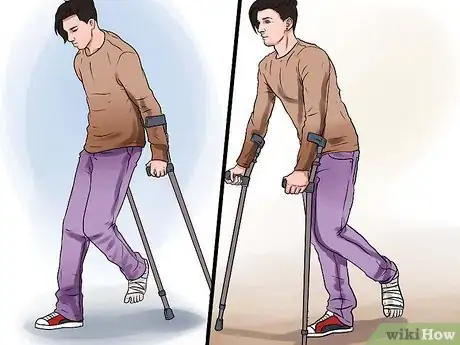
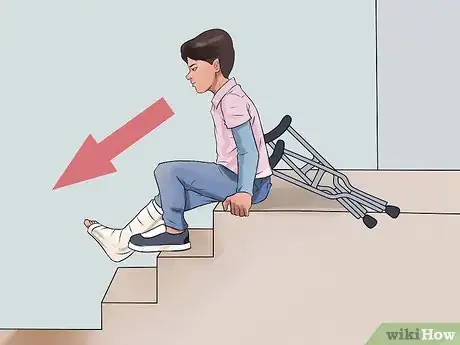




















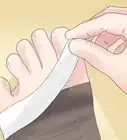






































Medical Disclaimer
The content of this article is not intended to be a substitute for professional medical advice, examination, diagnosis, or treatment. You should always contact your doctor or other qualified healthcare professional before starting, changing, or stopping any kind of health treatment.
Read More...